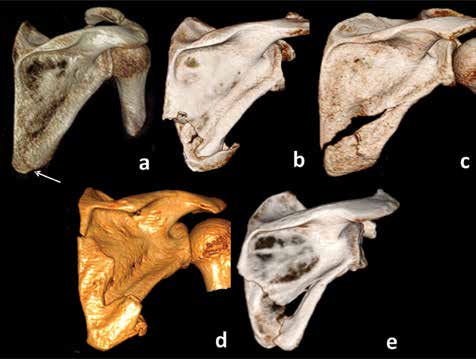Abstract
Introduction: The aim of this study is to describe the anatomy of fractures of the inferior angle and the adjacent part of the scapular body, based on 3D CT reconstructions.
Method: In a series of 375 scapular fractures, we identified a total of 20 fractures of the inferior angle of the scapular body (13 men, 7 women), with a mean patient age of 50 years (range 33−73). In all fractures, 3D CT reconstructions were obtained, allowing an objective evaluation of the fracture pattern with a focus on the size and shape of the inferior angle fragment, propagation of the fracture line to the lateral and medial borders of the infraspinous part of the scapular body, fragment displacement and any additional fracture of the ipsilateral scapula and the shoulder girdle.
Results: We identified a total of 5 types of fracture involving the distal half of the infraspinous part of the scapular body. The first type, recorded in 5 cases, affected only the apex of the inferior angle, with a small part of the adjacent medial border. The second type, occurring in 4 cases, involved fractures separating the entire inferior angle. The third type, represented by 4 cases, was characterized by a fracture line starting medially close above the inferior angle and passing proximolaterally. The separated fragment had a shape of a big drop, carrying also the distal half of the lateral pillar in addition to the inferior angle. In the fourth type identified in 5 fractures, the separated fragment was formed both by the inferior angle and a variable part of the medial border. The fifth type, being by its nature a transition to the fracture of the infraspinous part of the body, was recorded in 2 cases, with the same V-shaped fragment.
Conclusion: Fractures of the inferior angle and the adjacent part of the scapular body are groups of fractures differing from other infraspinous
fractures of the scapular body. Although these fractures are highly variable in terms of shape, they have the same course of fracture line and the manner of displacement.

